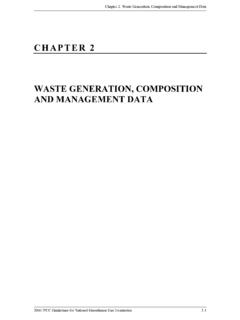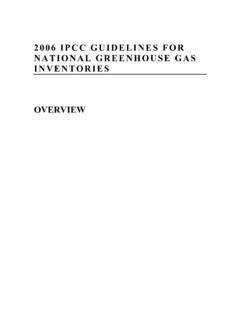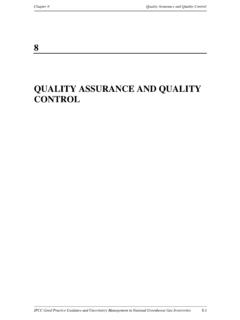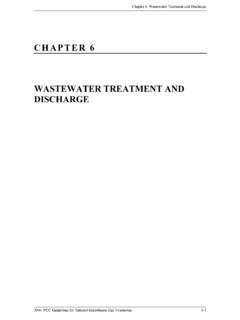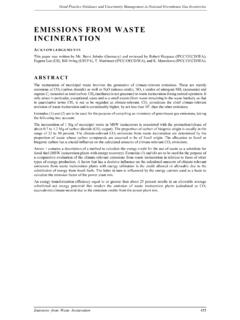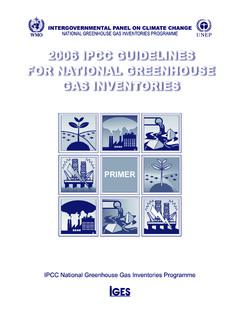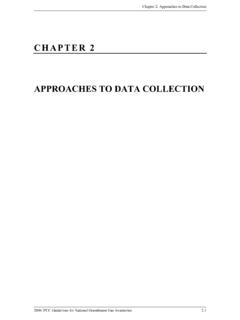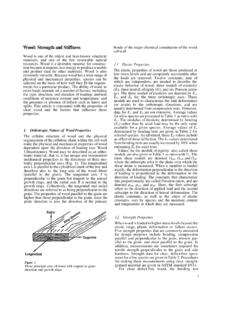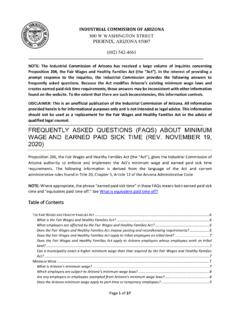Transcription of CHAPTER 4 FOREST LAND - IGES
1 CHAPTER 4: FOREST Land 2006 IPCC Guidelines for National Greenhouse Gas Inventories CHAPTER 4 FOREST LAND volume 4: Agriculture, Forestry and Other Land Use 2006 IPCC Guidelines for National Greenhouse Gas Inventories Authors Harald Aalde (Norway), Patrick Gonzalez (USA), Michael Gytarsky (Russian Federation), Thelma Krug (Brazil), Werner A. Kurz (Canada), Stephen Ogle (USA), John Raison (Australia), Dieter Schoene (FAO), and Ravindranath (India) Nagmeldin G. Elhassan (Sudan), Linda S. Heath (USA), Niro Higuchi (Brazil), Samuel Kainja (Malawi), Mitsuo Matsumoto (Japan), Mar a Jos Sanz S nchez (Spain), and Zoltan Somogyi (European Commission/Hungary) Contributing Authors Jim B. Carle (FAO) and Indu K. Murthy (India) CHAPTER 4: FOREST Land 2006 IPCC Guidelines for National Greenhouse Gas Inventories Contents 4 FOREST Land Introduction.
2 FOREST Land Remaining FOREST Land .. Biomass .. Choice of Choice of emission Choice of activity data .. Calculation steps for Tier Uncertainty Dead organic matter .. Choice of Choice of emission/removal Choice of activity data .. Calculation steps for Tier Uncertainty Soil Choice of Choice of stock change and emission factors .. Choice of activity data .. Calculation steps for Tier Uncertainty Non-CO2 greenhouse gas emissions from biomass Choice of Choice of emissions factors .. Choice of activity data .. Uncertainty Land Converted to FOREST Biomass .. Choice of Choice of emission Choice of activity data .. Calculation steps for Tier Uncertainty Dead organic matter.
3 Choice of Choice of emission/removal Choice of activity data .. volume 4: Agriculture, Forestry and Other Land Use 2006 IPCC Guidelines for National Greenhouse Gas Inventories Calculation steps for Tier Uncertainty Soil Choice of Choice of stock change and emission factors .. Choice of activity data .. Calculation steps for Tier Uncertainty Non-CO2 greenhouse gas emissions from biomass Completeness, Time series, QA/QC, and Reporting and Documentation .. Completeness .. Developing a consistent times series .. Quality Assurance and Quality Reporting and Tables .. Annex Glossary for FOREST Land .. Reference .. CHAPTER 4: FOREST Land 2006 IPCC Guidelines for National Greenhouse Gas Inventories Figures Figure Global ecological zones, based on observed climate and vegetation patterns (FAO, 2001).
4 Figure Global FOREST and land cover Tables Table Climate domains (FAO, 2001), climate regions ( CHAPTER 3), and ecological zones (FAO, 2001) .. Table FOREST and land cover Table Carbon fraction of aboveground FOREST biomass .. Table Ratio of below-ground biomass to above-ground biomass (R) .. Table Default biomass conversion and expansion factors (BCEF) .. Table Emission factors for drained organic soils in managed Table Above-ground biomass in forests .. Table Above-ground biomass in FOREST plantations .. Table Above-ground net biomass growth in natural forests .. Table Above-ground net biomass growth in tropical and sub-tropical FOREST plantations .. Table Above-ground net volume growth of selected FOREST plantation species.
5 Table Mean annual increment (growth of merchantable volume ) for some FOREST plantation Table Tier 1 estimated biomass values from Tables (Except Table ).. Table Basic wood density (D) of tropical tree Table Basic wood density (D) of selected temperate and boreal tree taxa .. volume 4: Agriculture, Forestry and Other Land Use 2006 IPCC Guidelines for National Greenhouse Gas Inventories Boxes Box Levels of detail .. Box Biomass conversion and expansion factors for assessing biomass and carbon in forests .. Box Examples of good practice approach in identification of lands converted to FOREST CHAPTER 4: FOREST Land 2006 IPCC Guidelines for National Greenhouse Gas Inventories 4 FOREST LAND INTRODUCTION This CHAPTER provides methods for estimating greenhouse gas emissions and removals due to changes in biomass, dead organic matter and soil organic carbon on FOREST Land and Land Converted to FOREST Land.
6 It builds on the Revised 1996 IPCC Guidelines for National Greenhouse Gas Inventories (1996 IPCC Guidelines) and the Good Practice Guidance for Land Use, Land-Use Change and Forestry (GPG-LULUCF). The CHAPTER : addresses all five carbon pools identified in CHAPTER 1 and transfers of carbon between different pools within the same land areas; includes carbon stock changes on managed forests due to human activities such as establishing and harvesting plantations, commercial felling, fuelwood gathering and other management practices, in addition to natural losses caused by fire, windstorms, insects, diseases, and other disturbances; provides simple (Tier 1) methods and default values and outline approaches for higher tier methods for the estimation of carbon stock changes.
7 Provides methods to estimate non-CO2 greenhouse gas emissions from biomass burning (other non-CO2 emissions such as N2O emissions from soils are covered in CHAPTER 11); should be used together with generic description of methods and equations from CHAPTER 2, and the approaches for obtaining consistent area data described in CHAPTER 3. The Guidelines provide methods for estimating and reporting sources and sinks of greenhouse gases only for managed forests, as defined in CHAPTER 1. Countries should consistently apply national definitions of managed forests over time. National definitions should cover all forests subject to human intervention, including the full range of management practices from protecting forests, raising plantations, promoting natural regeneration, commercial timber production, non-commercial fuelwood extraction, and abandonment of managed land.
8 This CHAPTER does not include harvested wood products (HWP) which are covered by CHAPTER 12 of this volume . Managed FOREST Land is partitioned into two sub categories and the guidance and methodologies are given separately in two sections: Section FOREST Land Remaining FOREST Land Section Land Converted to FOREST Land Section covers the methodology that applies to lands that have been FOREST Land for more than the transition period required to reach new soil carbon levels (default is 20 years). Section applies to lands converted to FOREST Land within that transition period. The 20-year interval is taken as a default length of transition period for carbon stock changes following land-use change. It is good practice to differentiate national FOREST lands by the above two categories.
9 The actual length of transition period depends on natural and ecological circumstances of a particular country or region and may differ from 20 years. Unmanaged forests, which are brought under management, enter the inventory and should be included in the Land Converted to FOREST Land. Unmanaged forests which are converted to other land uses enter the inventory under their post conversion land-use categories with the appropriate transition period for the new land-use category. If there are no data on land conversion and the period involved are available, the default assumption is that all managed FOREST land belongs to the category FOREST Land Remaining FOREST Land and greenhouse gas (GHG) emissions and removals are estimated using guidance given in Section Relevant carbon pools and non-CO2 gases The relevant carbon pools and non-CO2 gases for which methods are provided are given below: Biomass (above-ground and below-ground biomass) Dead organic matter (dead wood and litter) Soil organic matter Non-CO2 gases (CH4, CO, N2O, NOX) volume 4.
10 Agriculture, Forestry and Other Land Use 2006 IPCC Guidelines for National Greenhouse Gas Inventories The selection of carbon pools or non-CO2 gases for estimation will depend on the significance of the pool and tier selected for each land-use category. FOREST land-use classification Greenhouse gas emissions and removals per hectare vary according to site factors, FOREST or plantation types, stages of stand development and management practices. It is good practice to stratify FOREST Land into various sub categories to reduce the variation in growth rate and other FOREST parameters and to reduce uncertainty (Box ). As a default, the Guidelines use the most recent ecological zone (see Table in Section and Figure in this CHAPTER ) and FOREST cover (see Table in Section and Figure in this CHAPTER ) classifications, developed by the Food and Agriculture Organization (FAO, 2001).
